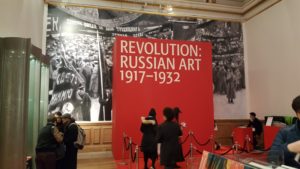Revolution: Russian Art 1917-1932 – Royal Academy, London

This exhibition, like many of the artworks in it, bears up well under the weight of history. For Revolution is firmly rooted in the historic context of the period 1917-1932 in Russia – a time of upheavals, civil war, dictators and hopes born and cruelly dashed. Despite this, it manages to educate, illuminate and engage, and is by far the best exhibition I’ve seen in the last few months.
A century on from the Russian Revolution, we have not just hindsight, but decades of popular, academic and artistic responses which colour our views of the period, and to some extent its artistic outputs. We all know the names of artists like Kandinsky and Chagall, and are familiar with socialist realism and its shortcomings v. ‘real’ art, but what the three curators have done very well is to weave these threads back into a historic narrative, which allows for a plurality of artistic voices reacting to the magnitude of events, broadcasting messages to their comrades, sharing their visions of the future and coming to terms with new political realities. Not all of the artists are well known, but the very fact that the vast majority of the works come from Russian collections sets the exhibition up as a one-off chance to explore and understand the period, and to go beyond the surface of art history.
Taking a 1932 exhibition on Russian art as its inspiration helped to focus and give variety to the RA show: a space dedicated to recreating Malevich’s original offering gives a moment’s respite from the march of history, while the blending of avant-garde and politically acceptable art in the 1932 exhibition gives a framework to seamlessly do the same in the current one. Thankfully there aren’t thousands of works on view here as there were in 1932, but the wide variety of media: paintings, models, textiles, ceramics, posters, photography, help once more to place the outputs of the art historic canon into context.
The realities of life in the USSR are never far from the surface in Revolution, and the exhibition ends on a sombre note, with a small space dedicated to displaying mugshots of ordinary citizens as well as some familiar faces seen earlier in the show. Dates of arrest and release/death/execution are confronting, and perhaps give context to the ‘lesser’ socialist realist output in the same room. If I could have added one more thing to this exhibition it might have been an understanding of the degree to which this narrative was mirrored (or not) outside of Russia in the periphery of the Soviet Union: the focus here is on Russian art so this is not necessarily a shortcoming, but perhaps rather an opening for a similarly intelligent exhibition with a wider geographical sweep in future.
Until 17 April


